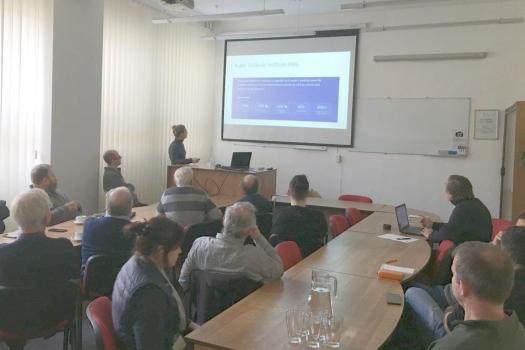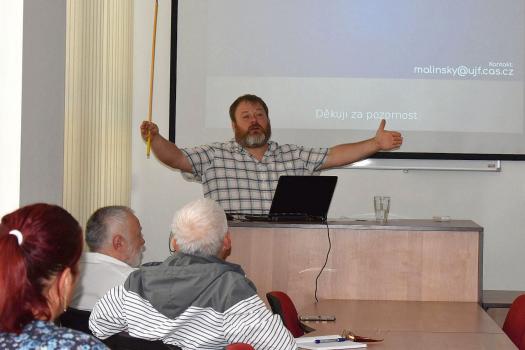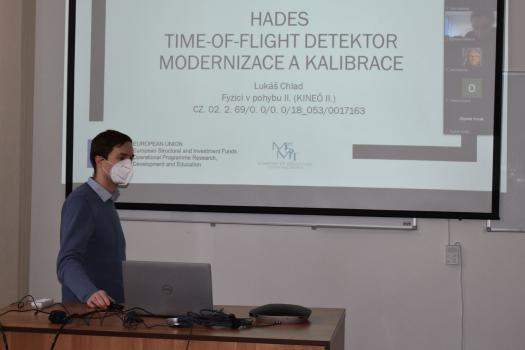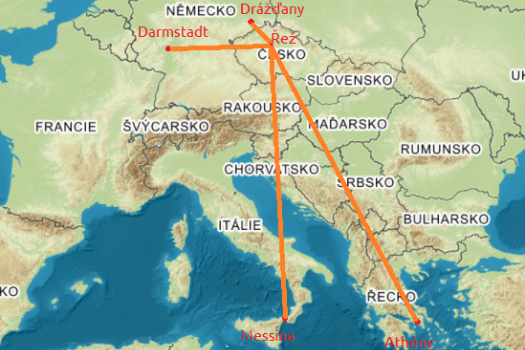Physicists on the move II. (KINEÓ II.)
The "Physicists on the move II." project (acronym: KINEÓ II.) is focused on the mobility of junior researchers, which the Nuclear Physics Institute of the CAS, v. v. i. (hereinafter referred to as NPI) plans to send to four leading foreign research institutes (FAIR Darmstadt, HZDR Dresden, University of Messina, NHFR Athens). The project also includes a one-year intership of a foreign young researcher at NPI of the CAS.
Thanks to a six-month to one-year internships, these employees will increase their professional knowledge, strengthen the international contacts of NPI and, upon their return, will strengthen the staff of its existing scientific teams. The selection of staff will take place through a transparent internal selection procedure.
The target group of the project is Ph.D. and post-doc students working in NPI, especially in the fields of theoretical physics, nuclear physics and the development of accelerators. This group is very promising for NPI, as it is based on a new generation of researchers.
In the return phase, which will be part of all internships, interns will transfer the acquired knowledge through direct interaction with their colleagues in scientific groups, at NPI joint seminars, working group meetings, presentation of results at conferences and leading younger students (Bc., high school students in Open Science project etc.). Seminars will also take place at universities cooperating with NPI (FMP CU, FNSPE CTU in Prague, Brno UT, Silesian University Opava). During the implementation of the project, joint publications will also be created.
The NPI website will regularly inform about project progress and individual key activities, including the experience of young researchers of work in foreign organizations.
The KINEÓ II. project, Reg. No. CZ.02.2.69/0.0/0.0/18_053/00017163, is supported by the Ministry of Education, Youth and Sports of the Czech Republic and from the European Structural and Investment Funds, the Operational Program Research, Development and Education.
Project duration: September 1, 2020 – August 31, 2022
Nuclear Physics Institute of the CAS, v. v. i., Husinec-Řež, Czech Republic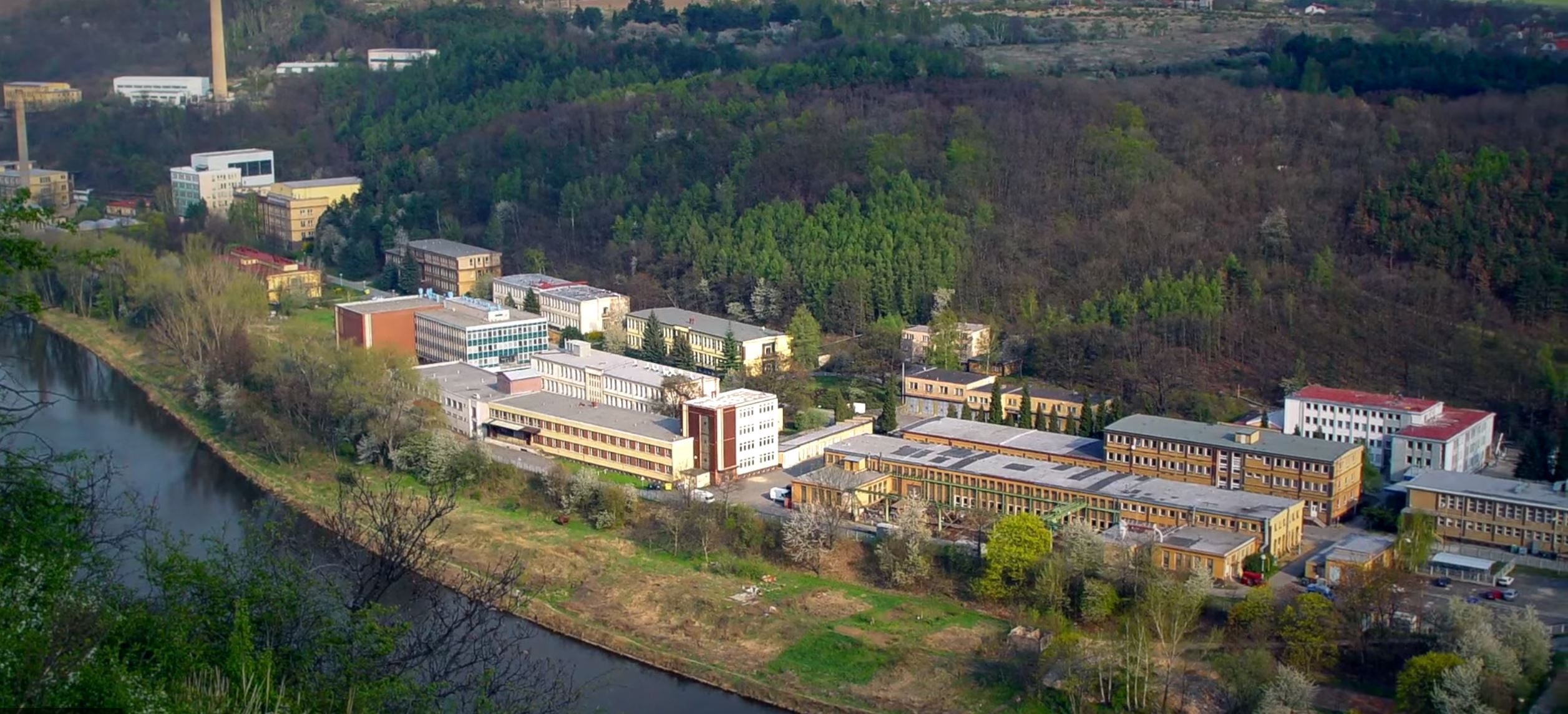
Mentor: Ing. Vít Jakubský, Ph.D.
The main topic of the mobility is a study of Dirac materials by methods of mathematical physics. The accepted post-doc will be involved in the ongoing research of these materials at the Department of Theoretical Physics of the NPI. He/she will develop new theoretical tools for the effective analysis of the low-dimensional Dirac equation or related equations used to describe the transport of charge carriers in single- or multilayer graphene. These newly developed methods, as well as the existing methods, should subsequently be used by the post-doc in the analysis of spectral and transport properties of charge carriers in the presence of external electromagnetic fields or deformations in graphene or related materials.
The benefit of this research lies in a better understanding of the physical properties of Dirac materials (graphene and related materials). The study of the so-called "trapping" of charge carriers in waveguides, with the potential for use in nanotechnologies, can be given as an example. Furthermore, the goal is also the development of new methods of mathematical physics suitable for the study of the low-dimensional Dirac equation, which in the end will also contribute to the possibilities of studying and applying the above-mentioned graphene-like materials. In addition to this factual benefit, there will also be a two-way transfer of skills and approaches between the employee's original workplace and the host institution (NPI).
Facility for Antiproton and Ion Research in Europe GmbH (FAIR), Darmstadt, Germany
Mentor: Prof. Dr. Tetyana Galatyuk
The main topic of the mobility is a calibration and preparation of the Time-of-Flight (TOF) detector after the upgrade of the read-out electronics for the next experiment within HADES, FAIR Phase 0. The researcher will perform commisioning, calibration of the detector, verify the functionality of the trigger system, perform test measurements using cosmic rays and analyze this data. The researcher will also get acquainted with the operation of the new electronics and its advanced capabilities. He/she will have ideal conditions for this in the form of cooperation with leading electronics experts (directly responsible for development and production), data acquisition systems and detectors in general. In addition to hardware tasks, the researcher is also involved in the analysis of physical data.
The HADES experiment specializes in measuring di-electron pairs produced in nucleon-nucleon collisions, as well as from proton collisions with nuclei and with nuclear-nuclear collisions. The studied electron pairs, as lepton probes in a strongly interacting mass, carry unique minimally distorted information. The TOF detector is part of the HADES spectrometer assembly and is responsible for the time information about the flight time, which is vital for determining the momentum in the collisions of the particles produced.
University of Messina - University degli Studi di Messina, Messina, Italy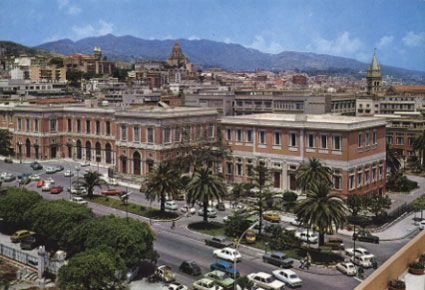
Mentor: Prof. Letteria Silipigni
The main topic of the mobility is a study of nanoparticle synthesis, their characterization and use in material physics with a focus on biomedicine and nuclear physics. The internship will take place at the Department of Mathematical and Computer Sciences, Physical Sciences and Earth Sciences, University of Messina. The researcher will be involved in all three steps in the research of nanoparticles: synthesis, characterization and then the possibilities of use. In this particular case, it is a synthesis by the method of laser ablation. Nanoparticles will be produced from various types of materials: metals (Au, Bi, ZnO, Gd etc. including alloys), non-conductors (polymers, ceramics, oxides, Al2O3, etc.) and also from semiconductors (Si, GaAs, SiC, diamond-like). Different ablation methods will be tested, especially the environment (liquids/gases/vacuum) as well as different wavelengths and repetition frequencies of lasers. In direct connection with the synthesis phase, the obtained nanoparticles will be studied by various spectroscopic techniques (SEM, TEM, EDX, Raman spectroscopy, UV-Vis-NIR and FTIR spectroscopy) in order to describe their physical properties in case of surface deposition or incorporation in the material. The application possibilities are very wide, from physical, through energy to biomedicine. As part of the mobility, the possibilities of incorporating nanoparticles into polymers, graphene oxide layers, graphite and other suitable materials will be tested.
General possibilities of application of nanoparticles in nuclear physics and biomedicine are, for example: use of graphene layers doped with nanoparticles (Au, Ta, W) to create effective strippers; use of biocompatible nanoparticles (Au, Ag, Bi) to improve the effect of radiotherapy and in the case of LiF or CrF3 to streamline proton therapy.
University of Messina - University degli Studi di Messina, Messina, Italy 
Mentor: Prof. Lorenzo Torrisi
The stay at the Plasma laser laboratory, Physics department, University of Mesina, will focus on the study of laser drawing of shapes and patterns on graphene-based materials. More specifically, it will be focused on a drawing into graphene oxide layer using nanosecond laser. This pattern drawing can change the electrochemical properties of the original layer, which opens up new possibilities for the use of these materials. One possible area is the detection of gases capable of detecting and monitoring concentrations of gases such as CO2, H2O, H2, O2, NO2, NH3 down to the the level of units of ppm (parts per million). Another interesting use is dosimetry, where changes in the oxide layer and thus electrical and possibly optical properties are affected by the absorbed dose in a measurable and predictable form.
In addition to the writing/drawing process itself, the researcher will also test the properties of the prepared samples (gas sensors and dosimeters). Within the framework of mobility, both mentioned sensors, gas and dosimetry, will be developed and subsequently tested. The morphology of the sensors will be tested by SEM, X-ray radiofluorescence and Raman spectroscopy. Research will thus help the development of new ultralight and flexible detection elements. The University of Mesina department was chosen because of long-term cooperation with NPI, instrumentation and highly experienced team. The researcher will thus deepen the cooperation of the NPI with the University of Mesina and will acquire new theoretical and practical skills, which will subsequently benefit the NPI.
Helmholtz-Zentrum Dresden-Rossendorf e. V. (HZDR), Dresden, Germany
Mentor: Dr. Rene Heller
The mobility will take place at the Ion Beam Center within the Institute of Ion Beam Physics and Materials Research in Helmholtz-Zentrum Dresden-Rossendorf (HZDR) and the researcher will be involved in activities related to ionic implantation of rare earths and transition metals into crystalline and amorphous materials. The purpose of this ion implantation will be to study changes in the electrical and optical properties of irradiated materials.
As part of his/her task, the researcher will participate not only in the implantation process, but also in the subsequent analysis of the obtained samples by RBS, RBS-channeling, ERDA and TOF-ERDA methods. The used substrates will be mainly GaN, ZnO, ZrO2 crystals and the implantation will be performed by ions accelerated to energies in the order of keV-MeV. The work will focus on the study of the relationship between optical and electrical properties to changes in crystalline materials with a hexagonal crystal lattice (ZnO, GaN) caused by ion implantation. These crystals are interesting for their unique properties and for their wide applicability in electronics, optoelectronics and other fields, where, depending on their structure and composition, they can serve as UV sources, chemical sensors, waveguides and opto-acoustic devices.
Specifically, the researcher will study the effect of crystal structure on the growth, morphology and depth distribution of rare earth nanoparticles and transition metals formed by ion implantation, as well as the degree of damage to crystal structure depending on the type and energy of ions used. The structural changes and damage caused by ion implantation have not yet been fully understood, and the study of the position of implanted atoms and their effect on the optical and electrical properties of crystals is an important topic in the study of these materials.
National Hellenic Research Foundation (NHRF), Athens, Greece 
Mentor: Maria Kandyla, Ph.D.
The mobility will take place at the National Hellenic Research Foundation (NHRF) and the researcher will study gas sensors based on thin layers of metal oxides. These sensors are exceptional especially in their ability to detect gases even in very low concentrations. Thus, they will find application not only in industry, air monitoring, science, but they can also be used in terms of safety, because they allow the detection of e.g. hydrogen and toxic gases from very low concentrations. Another field of use is medicine, where sensors show good conditions for the detection of gases in the breath and for medical diagnostics. Mention may be made here, e.g. acetone as an accompanying symptom of diabetic ketoacidosis, one of the complications of both types of diabetes mellitus. It is therefore a very promising research with high utility value.
Research and production of these sensors were also started two years ago at the NPI, but sensors produced at NHRF show higher and faster responses than sensors prepared at NPI. During the internship, the advanced knowledge and skills necessary for the production of high-quality sensors will be acquired. Due to the good equipment of the laboratory in the field of sensor characteristics and also the measurement of the composition of basic materials, the researcher will gain vital experience for the operation and development of the laboratory, built at the NPI. The laboratory at NHRF has long-term experience (and publication history) in the research of gas sensors based on metal oxides and is well equipped for the preparation of layers and the study of their structural and sensory properties. The researcher will be involved in the topic of sensors in the form of preparation of base materials and application of oxide layers. Subsequently, he/she will participate in the measurement and characterization of sensors.
Facility for Antiproton and Ion Research GmbH, Planckstr. 1, 64291 Darmstadt, Germany
University of Messina - University degli Studi di Messina, Piazza Pugliatti 1, 98122 Messina, Italy
Helmholtz-Zentrum Dresden-Rossendorf, Bautzner Landstrasse 400, 01328 Dresden, Germany
National Hellenic Research Foundation, 48 Vassileos Constantinou Ave., 116 35 Athens, Greece
Project manager:
RNDr. Ing. Petr Chudoba, Ph.D.
tel.: +420 266 173 152
e-mail: chudoba@ujf.cas.cz




